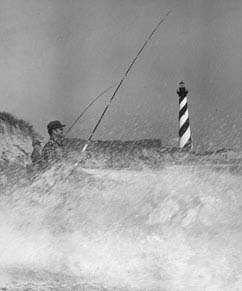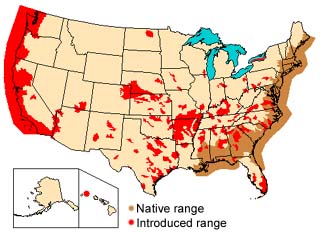|
|

FERTILIZED EGGS drift downstream with currents and eventually hatch into larvae.
LARVAE begin feeding on zooplankton as they are transported downstream. They mature into juveniles by the time they reach nursery areas, which are where the rivers empty into the estuary.
JUVENILES remain in the estuary for two to four years, and then migrate to the Atlantic Ocean as mature adults. They return to the estuary triggered by warm spring water temperatures, and continue the process.
SPAWNING AREAS: Chesapeake Bay and its tributaries are the primary spawning and nursery area for up to 70-90% of the Atlantic coast stocks of striped bass. The Hudson River in New York and rivers along the North Carolina coast are other important spawning areas.
(www.dnr.state.md.us/fisheries/education/rockfish/rockfish.html; www.chesapeakebay.net/info/striped_bass.cfm; www.nefsc.noaa.gov/sos/spsyn/af/sbass/)
The striped bass is a silvery fish with seven or eight dark, continuous stripes along the side of its body. It is anadromous. Figure 1 shows the distribution of striped bass in the U.S. Its native range along the Atlantic and Gulf coasts span from Maine to Florida, and then inland to Louisiana. The commercial and recreational popularity of this fish has prompted introduction of the striped bass to many locations throughout the U.S.
(www.dnr.state.md.us/fisheries/education/rockfish/rockfish.html; nas.er.usgs.gov/queries/SpFactSheet.asp?speciesID=787)
Most striped bass on the Atlantic coast take part in two types of migration activities, upstream spawning migration and coastal migration.
SPAWNING MIGRATION is triggered by the increased water temperature during April, May and early June in the Chesapeake Bay.
COASTAL MIGRATION occurs up and down the Atlantic coast depending on the season, and is not associated with spawning.
NON-MIGRATORY STOCK: bass from southern North Carolina to northern Florida do not undertake coastal migrations.
MIGRATORY STOCK: in Hudson Bay, Chesapeake Bay, and Roanoke sound
SUMMER/early FALL: migrate north to the nearshore waters of the New England coast.
late FALL/early WINTER: migrate south to North Carolina and Virginia Capes.
|
The striped bass was overfished all along the Atlantic coast during the late 1970s through mid 1990s. Production of juveniles from the Chesapeake Bay dropped to an all time low. This cascaded into precipitous declines of commercial and recreational striped bass landings all along the Atlantic coast. Poor recruitment for Chesapeake Bay was probably due primarily to overfishing; but poor water quality in spawning and nursery habitats likely also contributed. Figure 2 is a graph of North Carolina striped bass harvest from 1972 to 2002, and shows the dramatic decline during the 1970s to 1990s.
The Atlantic Striped Bass Conservation Act was adopted in 1984 to establish management measures on a federal level since striped bass were not exclusive to any one state. This included size limits, seasonal closures, recreational daily bag limits and annual commercial catch quotas. Fisheries are limited to state waters due to the continued moratorium on fishing for striped bass in the EEZ. During the mid 1980s, North Carolina adopted stringent management measures to help rebuild the Chesapeake Bay stocks.
The strict management efforts allowed juveniles to recover, which resulted in increased striped bass biomass overall. In 1997, the Albemarle/Roanoke striped bass stock in North Carolina was formally declared to be a restored stock, and restrictions were relaxed. Average landings from 1995 to 2000 were ~25% higher than those from 1982 to 1986. Recreational fishermen accounted for 75% of total landings.
|
- The striped bass is a major predator of blue crabs. Do you think its recent recovery can be responsible for the declining crab population since 1999?

This web site was created by Lynn Tran at the North Carolina State University, Department of Mathematics, Science, and Technology Education on 7/12/03. Faculty advisor Dr. David Eggleston, NCSU, Department of Marine, Earth, & Atmospheric Sciences. Last updated December 29, 2003 .

